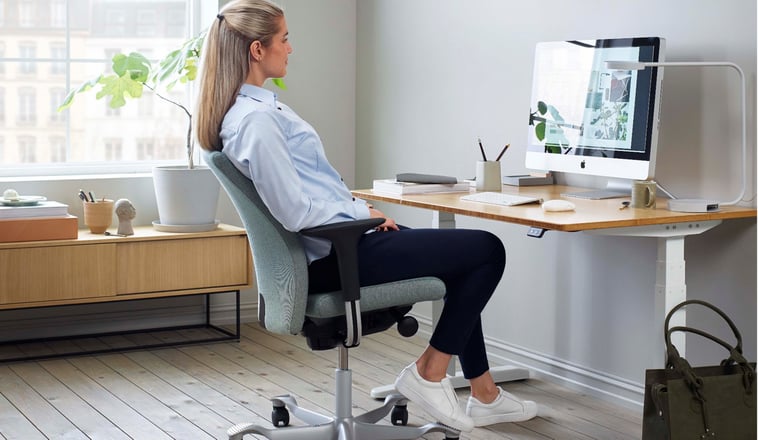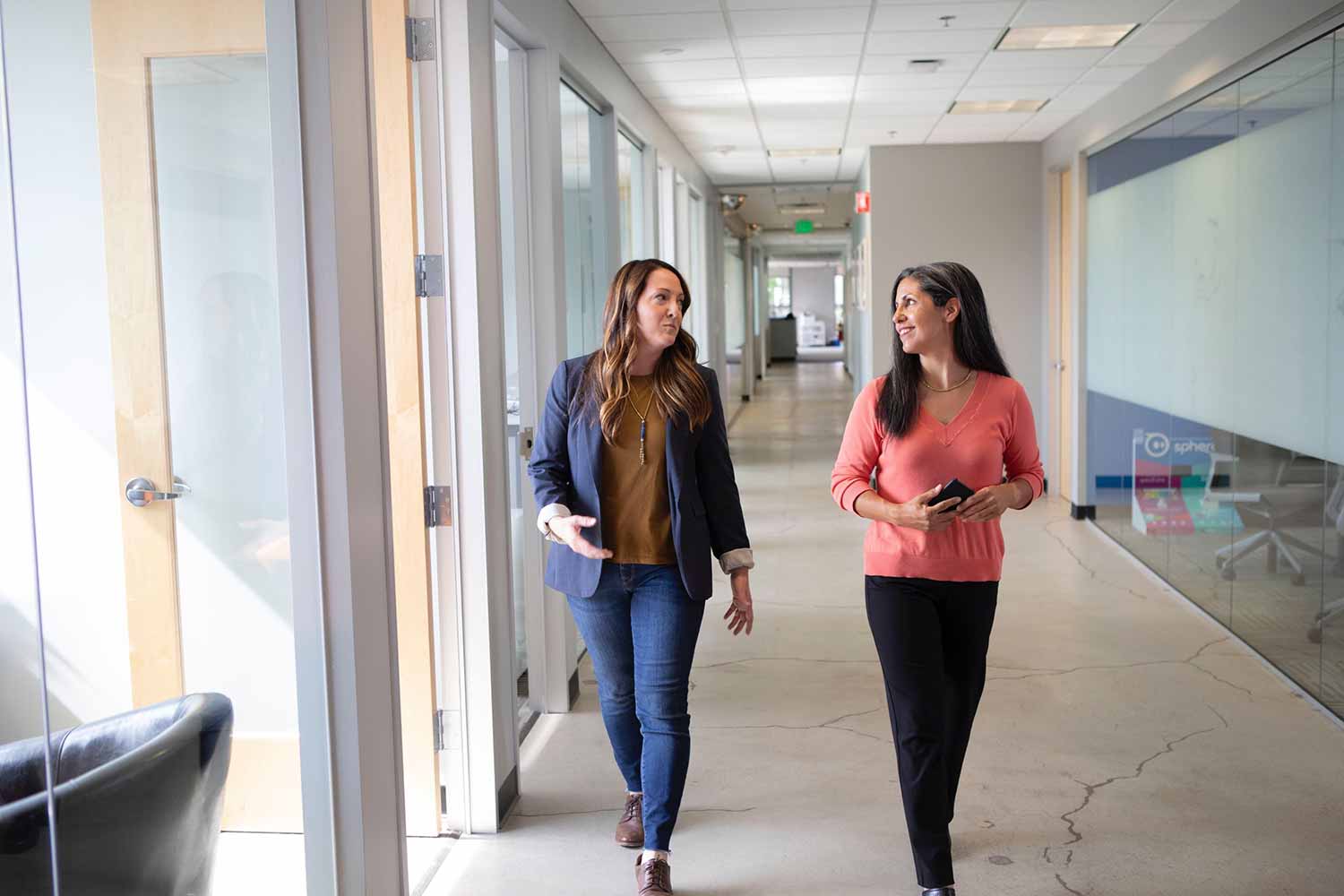
An employers guide to building an workplace ergonomics program
Workplace ergonomics consultant Kirsty Angerer guides us through the important steps every employer should consider when building a workplace ergonomics program

As many of us have transitioned to working from home for the foreseeable future, there have been many positive changes to this interim period of working such as no commuting time, more time with family, more time to exercise and enjoy nature. There have also though been some negatives which include lack of space or equipment to work properly, home and work life being intertwined and loneliness.
Working from home isn’t a new concept but the number of people working from home and all week has certainly increased over the last few months. Most people aren’t used to working from home and most will certainly not have the right equipment or know how to do so productively and without pain or discomfort.
In the office, people would’ve had a better opportunity to be working with good ergonomic equipment (at least we hope so), more space to move around and better interaction with colleagues. Whilst space is something we may not be able to control in everyone’s homes or the physical interaction with people, we can certainly implement workspace solutions at home much the same as that in the office.
What you’ll find is that no matter where you are working from, we can use ergonomics principles to guide you on the journey of educating staff with the goal of optimizing people’s health and performance.
So, what is Ergonomics?
Ergonomics is all about enhancing your performance through good design whilst also keeping you safe and healthy.
It's derived from the Greek words Ergon meaning to work and Nomos meaning natural laws.
You may be interested to know that the study of ergonomics began after WW2 when scientists realized that many aircraft crashes occurred due to poor design.
In the 1960s the discipline extended to computer equipment followed by the study of computer software in the 1970s.

Today the science of ergonomics is a combination of various disciplines; including applied psychology, social psychology, engineering, anatomy and physiology, biomechanics and inclusive design.
And it's related to anything and everything you interact with in life.
What we’re trying to achieve with ergonomics is to get you thinking about your environment and how you interact with it day-to-day.
Unfortunately, poor design is everywhere but there are things we can do to put our bodies in the best position possible for the task at hand.
Understanding what ergonomics is, is a key part of the process when building a program. Making sure everyone is on the same page and with the same goal in mind.
Ergonomics is literally about human-centred design, which is a design that develops solutions to problems by involving the human perspective in all steps of the process. One person alone will not be able to achieve a great ergonomics program.
Most people think it’s the health and safety persons role only but in fact, there are a whole host of people who should be involved and it’s the only way you can make this a success.

So, who should be the key stakeholders?
Of course, the facilities team should be involved because they are responsible for making sure that buildings and services meet the needs of the people that work in them. This team are still a vital component even with many of us working from home as they’ll be managing our safe return to the workplace, along with supporting us at home.
HR, because they are responsible for many people related issues in an organisation.
Your health and safety professional, as they are science-based and will report on any risk assessments conducted.
IT, the people who purchase computers, mice and keyboards. They should understand what tech products they should purchase for employees rather than just buying standard products that may not be of benefit.
Creating a design standard for all products could help to reduce costs and increase efficiencies.
Procurement, they are the ones who will most likely pay for this program so they need to be involved so they can understand the financial implications and benefits and can then budget for it each year.
All of these people play an important role in the successful running of an ergonomics program. Whilst everyone just discussed should be part of the process, a leader should be chosen to bring everyone together and make sure everyone adheres to the goals of the program.
I guess it doesn’t really matter who that person is as long as they are passionate about the success of the program, have respect from other team members and will get things done!
Now we need to review everything.
If you currently have some kind of program in place, understanding if it’s reactive or proactive is important.
When I refer to a reactive program I mean for example when an employee has an issue, you as a business react at the point. You may react by supplying equipment, organizing an assessment or having further discussions.
A proactive program is putting measures in place so that as a business you can minimize employee ill health and reduce costs. In fact, it’s not just about minimizing issues but encouraging a program that allows people to thrive in their working day.
In reality, you want a program that is both proactive and reactive because whilst you can account for most things, some issues may arise that are outside of your control.
Taking a bird’s eye view and understanding if there are any gaps in your program would be a good first step. Some questions to ask are how you manage the onboarding of new starters, how you educate staff on ergonomics, what format does that take, how you’ve considered your working from home policy, What are employees entitled to from an equipment and technology perspective at home, and how you assess and document this process.
Read - Office talk: Health & wellbeing when working from home

Understanding the law is important so that you are compliant. As it stands in the UK (where I am based), you’ll want to investigate the DSE (Display Screen Equipment) regulations compiled through the health and safety at work act. These were published in 1992 and updated in 2002. Given the age of the regulations, these should be used to establish a minimum criterion for your program.
Currently, the health and safety executive have suggested that staff working from home are doing so on a temporary basis and therefore there are no additional risks to working from home. This means that individual DSE assessments don’t need to be carried out.
This may not be the case in every country so it is worth checking out the current mandates in your own region.
You do however still have a duty of care to your staff so making sure you do check in regularly and provide some form of education and resources to help staff whilst they are at home is crucial. You don’t want them coming back to the office worse than when they left. I would certainly also provide an assessment process for those who previously have required specialist equipment, those who are pregnant or on maternity leave and anybody who requires further support.
See my previous article to learn more about home workstation setup.
When it comes to educating your staff and managing an ergonomics program there are many ways you can do this.
You can integrate a management system that issues automatic self-assessments.
Self-assessments are great because they allow you as the business to capture a lot of data and quickly. For example, let’s say you have 1000 people in your company. It would take two and a half years to complete all the assessments face to face and by the time you were finished, you’d have to start all over again.
With self-assessment type software’s, you can collect this same information within a couple of hours. You can then prioritize the people that require additional support.
Whilst self-assessments are good, they don’t give your employees the ultimate benefit of having an ergonomist assessing them face to face. So, alongside a self-assessment management system, you should filter into your program regular seminars or webinars and newsletters that keep staff up to date on the new trends. Workstation setup is important but so is understanding the ambient environment and the importance of movement.
In the modern world, technology and our modern way of life have reduced the need for movement against gravity which affects the human body in a similar way to the astronaut’s anatomy and physiology in microgravity.
A study conducted by former life scientist Joan Vernikos suggests that we should be interrupting sitting and standing at least 32 times per day to benefit our health.
So, movement is key.

As you have probably realized there is a lot to consider when implementing an ergonomics program but hopefully this information has got you thinking about your program and any changes that you may need to make to improve it.
An ergonomics program is an annual commitment. You should be doing workshops every quarter and have regular newsletters going out to reiterate the information.
You may wish to do the self-assessments annually. My personal thought is if nothing drastic has changed then every 2 years is probably sufficient.
There are 3 times you should do an assessment;
- When there is a new starter
- When someone has become injured
- When there is a significant office move or change
And in case you were wondering, according to the UK National Business Group on Health you can achieve a return on investment of 3:1 and up to 15:1 when implementing an ergonomics program. There are also indirect benefits such as a better health and wellness culture at work, productivity increases and happier employees.
There is usually a payback period of 6 months and I’ve often found that businesses will reap the benefits much earlier than that.
Kirsty Angerer is the founder of the Travelling Ergonomist, a workplace consultancy firm specialising in helping companies develop and maintain healthy business practices to maximise employee wellbeing and productivity.
This might also interest you
The Office Dilemma: Unveiling the Battle for Focused Workspaces
A recent survey conducted by Stockholm-based architects MER Arkitekter...
Giroflex 40 : active seating for active lifestyles – Ft. VAST:
Embracing the fusion of high-precision filmmaking and adrenaline-fueled...
Unravelling the impact of neurodesign: How built environments shape workplace experience
Flokk collaborates with leading neurodesign scientist Isabelle Sjövall on...